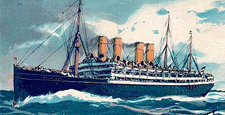
Although all ships call to me, and have since I was a boy, there is one that holds a special place in my heart: the Cecilie . Her full name was Kronprinzessin Cecilie and she was one of the great ships of her day: the youngest and fairest of four Teutonic sisters designed to lure passengers away from the British Cunard. Cecilie was always special. The last of the German four-stackers, she was sleek and fast and attentive to detail. Her first class dining room sported a fish tank to provide the very freshest of fare for her passengers. Such niceties earned her, and her popular Master, Captain Pollack, a beloved following. Many of America's elite would only sail aboard the Cecilie , earning her the sobriquet of "Millionaire's Special." However, another nickname would supplant that moniker: The Magic Ship¸ for her "magical" escape from the perils of the Great War.
When hostilities broke out, the Cecilie was in mid-ocean, headed for Germany. Onboard was her usual glittering array of passengers and an even more glittering cargo: gold and silver bound for Europe. Knowing that the English would attempt to seize - and possibly even sink - Cecilie , Captain Pollack made a bold decision. Under cover of night, he sent crewmen aloft to paint Cecilie's funnel tops black, hoping that from a distance she might be mistaken for the British liner Olympic ( Titanic's sister) of the White Star Line. Then, doing a mid-Atlantic about face, Pollack steered his ship for the still-neutral United States and a port deep enough to hold and hide Cecilie but not one so popular as to attract the British Navy. The next morning, the residents of Bar Harbour, Maine awoke to find the "Olympic" moored practically in their front yards. The ruse worked, and Cecilie spent a week as guest of the tiny town, several of the crew becoming "friendly" with the local inhabitants. Later, Cecilie was escorted to Boston where she remained, safely neutral, until the U.S. entered the War in 1917. Then, confiscated by the United States and renamed Mount Vernon¸ she served with distinction as a troop ship - at one point even surviving a torpedo attack from her former countrymen! After the war, she continued to serve, even in naval gray, very much a lady. She finally was retired to Virginia's mothball fleet where she remained until 1940 when she was towed to Baltimore and scrapped.
